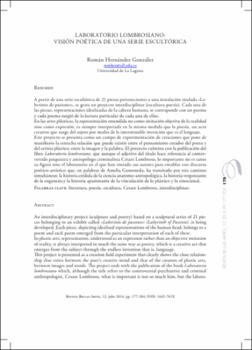Laboratorio Lombrosiano: visión poética de una serie escultórica
Author
Hernández González, Román
Date
2014Abstract
A partir de una serie escultórica de 21 piezas pertenecientes a una instalación titulada «Laberinto de pasiones», se gesta un proyecto interdisciplinar (escultura-poesía). Cada una de las piezas, representaciones idealizadas de la cabeza humana, se corresponde con un poema y cada poema surgió de la lectura particular de cada una de ellas. En las artes plásticas, la representación entendida no como imitación objetiva de la realidad sino como expresión, es siempre interpretada en la misma medida que la poesía, un acto creativo que surge del sujeto por medio de la interminable invención que es el lenguaje. Este proyecto se presenta como un campo de experimentación de creaciones que pone de manifiesto la estrecha relación que puede existir entre el pensamiento creador del poeta y del artista plástico; entre la imagen y la palabra. El proyecto culmina con la publicación del libro Laboratorio lombrosiano, que aunque el adjetivo del título hace referencia al controvertido psiquiatra y antropólogo criminalista Cesare Lombroso, lo importante no es tanto su figura sino el laboratorio en el que han entrado sus autores para entablar este discurso poético-artístico que, en palabras de Amelia Gamoneda, ha transitado por tres caminos simultáneos: la historia crédula de la ciencia anatomo-antropológica, la historia vergonzante de la eugenesia y la historia apasionante de la vinculación de lo plástico y lo emocional. An interdisciplinary project (sculpture and poetry) based on a sculptural series of 21 pieces
belonging to an exhibit called «Laberinto de pasiones» (Labyrinth of Passions) ,is being
developed. Each piece, depicting idealised representations of the human head, belongs to a
poem and each poem emerged from the particular interpretation of each of these.
In plastic arts, representation, understood as an expression rather than an objective imitation
of reality, is always interpreted in much the same way as poetry, which is a creative act that
emerges from the subject through the endless invention that is, language.
This project is presented as a creation field experiment that clearly shows the close relationship
that exists between the poet’s creative mind and that of the creators of plastic arts,
between images and words. The project ends with the publication of the book Laboratorio
lombrosiano which, although the title refers to the controversial psychiatrist and criminal
anthropologist, Cesare Lombroso, what is important is not so much him, but the laboratory which the authors visited to launch this poetic-artistic discourse and which, in the
words of Amelia Gamoneda, has covered three simultaneous paths: The credulous history
of anatomical-anthropological science, the shameful history of eugenics and the thrilling
history of the correlation between that which is plastic and that which is emotional.





